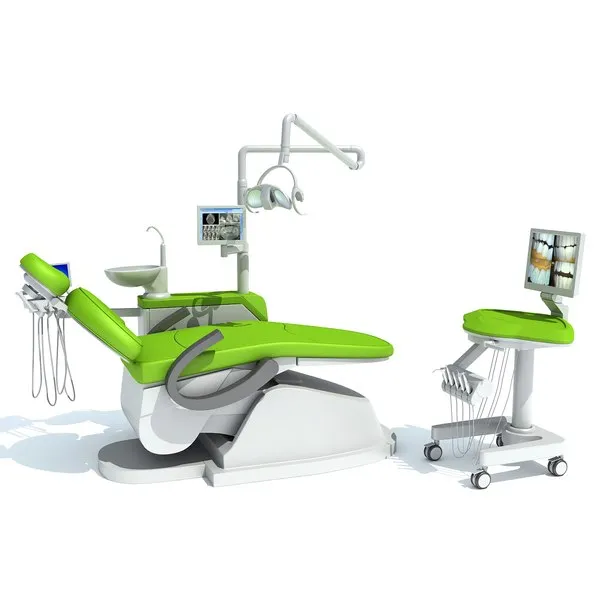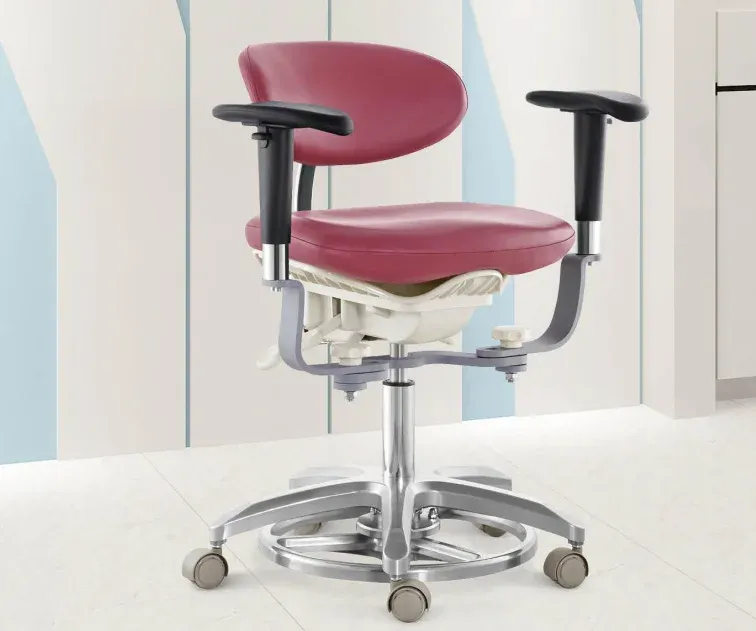Why Choosing the Right Dental Chair Is Important
Selecting the right dental chair is crucial for operating a dental clinic!
How to choose a suitable dental chair for a dental clinic? This is a common challenge for every dental clinic, whether they are starting up or upgrading. With the global awareness of oral health increasing, the dental industry is experiencing rapid growth. This, in turn, has led to a growing consumer base that demands higher professionalism from dental clinics. Meanwhile, more and more professional dentists are entering the field, ready to make their mark. At this stage, they need a professional dental chair, which will be their close ally for a considerable period.

For dental clinics, a professional dental chair brings convenience and efficiency to the dentist’s work, improving operational efficiency. It also offers a comfortable experience for clients, increasing the likelihood of repeat business. A professional dental chair, with its consistent quality, can significantly save operational costs for the clinic.
However, with a plethora of brands and varying qualities of dental chairs on the market, what exactly makes a dental chair professional in the eyes of a dentist? What are the key points to consider when selecting a dental chair for a clinic? Let’s analyze these aspects one by one.
Steps to Choose a Good Dental Chair
Follow our 7 steps to choose the best dental chair.
Step 1: Dental Chair Design
Firstly, consider whether the dental chair has a sophisticated design and precise craftsmanship.
- Is the appearance of the dental chair sleek and minimalist in design?
- Does the color scheme of the dental chair align with current fashion trends? Are there enough options to choose from?
- What is the texture like for different parts of the dental chair? Is it finely crafted?
- Is the joint movement of the dental chair smooth enough?

In today’s society, where public aesthetic awareness is heightened, a dental chair is no longer just a simple treatment tool for dental clinics. It has become an essential part of clinic decor. The lines, colors, and texture of the dental chair in the treatment room represent the style and taste of the clinic and the dentist. These aspects significantly influence the purchasing decisions of the clinic’s target customer base. Generally, the more precise the craftsmanship, the better the quality of the dental chair.
Step 2: Dental Chair Stability
Stability refers to the sturdiness of the dental chair.
- How much weight can a dental chair hold?
- How long does it take for the dental chair to return to a stationary state after being shaken vigorously?
- Do the oral light and tool tray move when a patient gets on or off the chair or when they rinse their mouth?
The load capacity of a dental chair is generally around 200kg, In our extensive research on the use of numerous dental chairs, we found that the stability of the chair is one of the attributes most concerned by dentists. The sturdiness of the dental chair directly affects the smoothness of oral treatments. If the chair is not stable enough, patients may struggle to feel secure during treatment, and a frequently shaking chair can also impact the efficiency of the dentist’s work. Therefore, “stability” is the second attribute that needs to be considered in a professional dental chair.
Step 3: Dental Chair Durability
Durability includes both the longevity of the dental chair and its resistance to disinfection.
- How many years is the registered lifespan of this dental chair?
- Have the dental chair’s oral light, foot pedal, backrest, seat cushion, and other components undergone reliability testing?
As the most fundamental medical equipment in a dental clinic, the lifespan and malfunction rate of a dental chair are closely linked to the clinic’s operating costs. Using a dental chair beyond its recommended lifespan can even pose regulatory risks. Therefore, durability is an important criterion for assessing the quality of a dental chair. A professional dental chair must be durable, a quality that should be evident not only in the chair as a whole but also in each of its frequently used components.

Moreover, the resistance of the dental chair to disinfection is crucial. In the post-pandemic era, the importance of infection control has increased dramatically. The dental chair in the clinic is subjected to high-frequency, high-intensity disinfection almost daily, a demand that was unimaginable for previous generations of dental chairs. Therefore, in the post-pandemic era, a professional dental chair must be specifically designed to withstand disinfection.
- Has the leather material of the dental chair been upgraded for corrosion resistance? Is it prone to fading or cracking?
- Can the casing and metal parts of the dental chair withstand frequent surface disinfection?
- What material is used for the drainage pipes of the dental chair? Is it corrosion-resistant?
Step 4: Dental Chair Cleanliness
- Can the dental chair achieve complete disinfection coverage for the water supply, triple syringe, and handpiece hoses?
- Is the dental chair equipped with a professional disinfection system? Can it comply with various levels of disinfection requirements?
- Is the waste outlet at the bottom of the dental chair securely sealed from the clinic’s drainage system?
In terms of clinic cleanliness, the cleanliness and infection control of the waterlines in the dental chair are undoubtedly the most crucial. This is because the water used for treatment, which comes through these lines, comes into direct contact with the patient’s mouth and can even enter the body. Neglecting this aspect could potentially lead to medical accidents. Regulatory authorities are also increasingly stringent about the control of water used in treatment. Moreover, the hygiene of the clinic environment also affects the patient’s treatment experience. Therefore, ensuring the cleanliness of the treatment room is a critical issue that every dental clinic must pay attention to.
Step 5: The Ease of Operation of the Dental Chair
Can the dental chair enable the dentist to work comfortably?
- Is it strenuous to continuously pick up and place tools from the dental chair’s instrument tray?
- How high does one need to lift their foot when stepping on the dental chair’s pedal?
- Does holding the suction handles at the assistant’s position for a long time cause hand fatigue?

Research shows that 96% of dentists experience musculoskeletal pain in at least one body part due to long procedures and highly repetitive movements. The most common complaints are back and neck pain, followed by pain in the shoulders, wrists, hands, hips, knees, and ankles. A professional dental chair should pay attention to every detail of the dentist’s operations, making each step of the treatment more effortless and flexible, thereby reducing the workload and strain on the dentist.
Step 6: Dental Chair Comfort
Comfort focuses on the experience of different users of the dental chair, encompassing both the ease of the dentist’s operations and the patient’s comfort during treatment.
- Can the dentist easily access all areas around the middle of the backrest while sitting in a normal position?
- Does the dentist have enough legroom when operating the dental chair?
- Is sitting in the dentist’s chair comfortable for extended periods?
- Is the thickness, firmness, and elasticity of the dental chair cushion appropriate? Is the surface touch smooth?
- Does the patient feel stable during the lifting and tilting operations of the dental chair?

When a dentist treats a patient, the role of the dental chair is to support the patient in a way that facilitates the dentist’s work. The closer the distance between the dentist and the patient, the easier it is to perform various operations. The design of the dental chair determines the distance between the dentist and the patient during treatment and also affects whether the dentist can adopt a healthy working posture. Achieving a good balance between the physical support for the patient and the convenience of treatment for the dentist is one of the standards for measuring a professional dental chair.
The comfort level of the dental chair also directly affects whether patients can have a comfortable treatment experience. It can alleviate the patient’s anxiety to some extent, thereby spreading good word-of-mouth and increasing repeat business for the clinic. A professional dental chair considers patient treatment experience in various aspects, such as the feel of the backrest cushion, seat tilting, and elevation adjustments.
Step 7: Dental Chair Price
How much does a dental chair cost? how much is a dental chair?
Typically, the price of an entry-level dental chair produced in China ranges from $1,000 to $1,500. A well-equipped chair costs around $2,500 to $3,000. If one wishes to purchase a higher-quality dental chair and has a larger budget, one can consider dental chairs from Taiwan, Germany, the United States, Japan, and South Korea.
As a core asset of the clinic and a durable good, it is advisable to allocate a higher budget for a dental chair, choosing one with good features and ergonomic design. This not only enhances the comfort of the dentist at work but also improves the comfort of patients during treatment.

Conclusion
In conclusion, choosing the right dental chair is vital for a dental clinic’s success. Key considerations include design, durability, stability, and comfort for both dentists and patients. Look for sleek, modern designs and reliable craftsmanship. Ensure the chair is sturdy, with a long lifespan and resistance to high-intensity disinfection. Comfort is crucial – the chair should facilitate the dentist’s work and provide a comfortable experience for patients. Finally, budget wisely; while entry-level chairs in China range from $1,000 to $1,500, investing more can bring better ergonomics and quality, with top options available from countries like Taiwan, Germany, the USA, Japan, and South Korea.
KINSUN Dental is a dental equipment supplier, we can provide you with a full range of dental products, the best price, and the fastest delivery, contact us for support.





